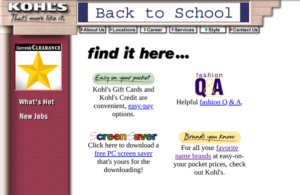Over the past year, marketers got a crash course in remote work.
As 2021 approached, many of us had already invested in at-home desks, workout equipment, and other tools meant to make work-from-home a little easier.
At the top of that list? Video conferencing software.
Video conferencing tools saw a 500% increase in demand in 2020 as a result of the worldwide pandemic. And, as the workforce continues to shift to a more flexible, hybrid model, it’s critical your business invests in equipment designed to foster collaboration regardless of an employee’s location.
But video conferencing software isn’t always cheap, and the fancy bells-and-whistles aren’t always necessary for small businesses looking for a simple, effective solution.
Here, we’ve compiled 10 of the best video conferencing tools for small businesses, ranging in price and features, to help you find the best fit for your needs.
But first — what are the benefits of video conferencing software, and do you need it, anyway?
Video Conferencing Benefits
Video conferencing offers opportunities for collaboration, productivity, and increased engagement with colleagues, stakeholders, and customers — all without the hassle (and cost) of traveling to an in-person location.
I could write a whole blog post about the benefits of video conferencing, but for our purposes, let’s focus on four:
- Video conferencing is a cost-effective opportunity to have face-to-face interactions with colleagues, prospects, stakeholders, or customers. It’s more personal and engaging than a phone call, and it’s much cheaper and more efficient than paying to commute — or fly — to a physical location to meet someone for an in-person conversation.
- Like mentioned above, video conferencing offers an opportunity for more personal connection. Eye contact, facial expressions, and body language are cues we use to effectively communicate with one another on a daily basis — and those cues are all lost in a phone or email conversation.
- Video conferencing can increase your team’s productivity, since it limits the amount of time you spend running to conference rooms in-between meetings, driving to meet a client, etc.
- Video conferencing can foster increased collaboration, as opposed to email or Slack. For instance, if I hear an interesting project a colleague is working on, I’ll ask them to join a quick Zoom call with me so we can discuss opportunities for collaboration — which is much more efficient than emailing about it.
However, video conferencing software can be expensive, and if you work for a small business with limited resources, it can be difficult to persuade leadership that it’s a worthwhile investment. Fortunately, you don’t have to break the bank to test it out — in fact, a few of the tools in this list are free forever, and others offer free trials.
Let’s dive into the most impressive video conferencing tools we’ve found for small businesses.
10 Best Video Conferencing Tools for Small Businesses
1. Zoom
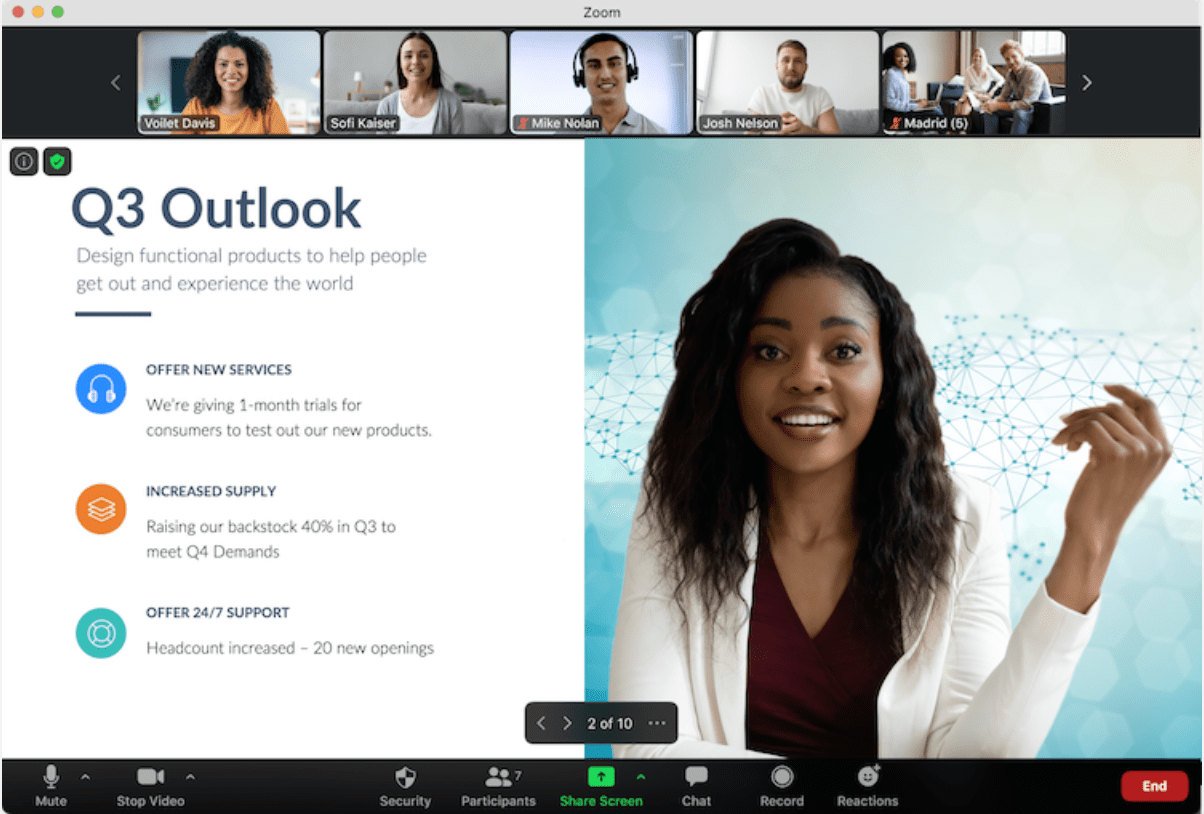
Pros: If you’re on a tight budget, you can’t beat the free option you get with Zoom, one of the highest-rated video conferencing tools available. The tool offers clear audio with background noise suppression, an option to share your screen, and a recording function to save and send the meeting to those unable to participate.
Additionally, Zoom has a few fun, engaging tools for increased participation among attendees — including filters, reactions, polls, hand raising, and chat. Plus, you can schedule a Zoom meeting right from your Outlook, Gmail, or iCal email calendar.
Zoom is also part of the HubSpot ecosystem and connects seamlessly with your CRM.
Cons: Outside of meetings, Zoom doesn’t offer any collaboration tools such as file sharing or messaging to follow-up with colleagues — additionally, the links you might’ve shared in the Zoom chat aren’t saved anywhere for later viewing. You also can’t add a meeting agenda to the invite from the app itself.
Overall, Zoom is a great option for small teams, but as you scale, there are some growing pains. For instance, you can get 100 participants in a meeting for 40 minutes with the free version, but if you have a company of 100+, you’ll need to pay more to increase participants.
Price: Free for Basic, which includes the ability to host up to 100 participants, up to 40 minutes of group meeting time, and unlimited one-on-one meetings. $149.90 per year for Pro version, which is recommended for small teams, and $199.90 per year for Small & Med Businesses version.
2. Jiminny
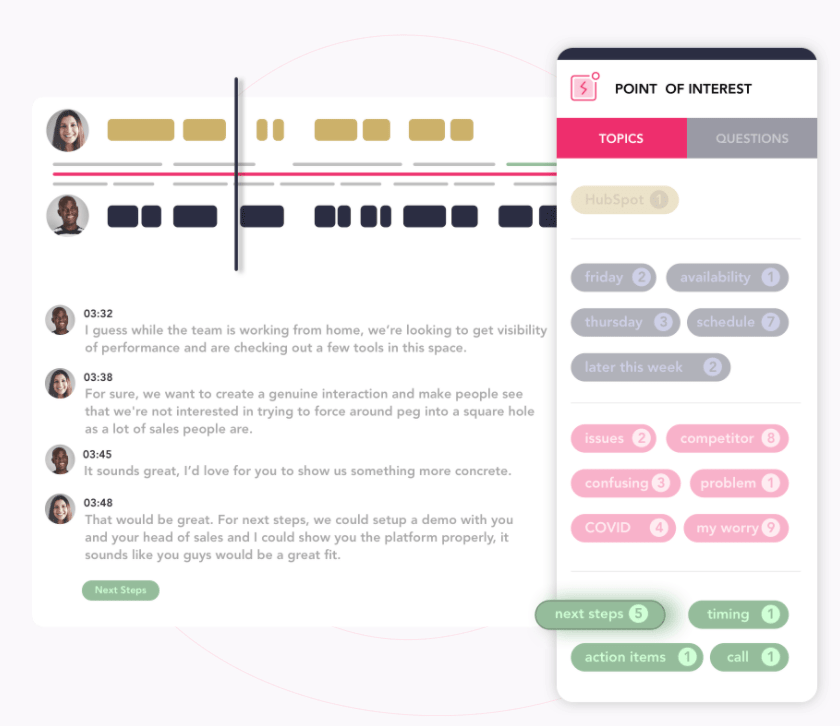
Pros: Jiminny offers a ton of unique, impressive features that can be particularly useful if you’re hoping to use your video conferencing tool for your sales team or for client-facing purposes.
For instance, the software offers a “Themes” feature, which means your meeting recording will be automatically broken up into important parts like “Next Steps” — for anyone who’s ever scanned an hour-long meeting recording looking for a two-minute conversation right in the middle, this can greatly increase efficiency with follow-up materials.
The recording feature can integrate with your CRM to automatically input data from your recordings, enabling you to reduce the time-consuming task of manual note-taking. The software also offers metrics such as ratio of talking versus listening to improve your sales reps conversation (and listening) skills.
Cons: The company is in the early-stages, so as they continue to iterate and improve on their product, you might experience some growing pains. Additionally, if you’re not planning on using the video conferencing tool for prospect/customer-facing purposes, some of these features might be unnecessary for your internal marketing team.
Price: Pro plans starting at $75/month per user if you sign up for a full year; that goes up to $95/month per user if billed monthly.
3. Google Meet

Pros: Google Meet is an incredibly cheap and easy-to-use video conferencing tool for small teams. In fact, if you’re not interested in recording or storing meetings, the tool is free forever for up to 100 participants.
Google Meet integrates with other apps and even lets you build a custom app using Apps Script. The tool also comes with unlimited Google Drive storage.
Additionally, the tool offers a speech-to-text real-time captioning feature for video chats and meetings — ideal for hearing impaired participants, non-native speakers, or participants with noisy backgrounds.
Cons: The free version doesn’t offer the ability to record or save your meetings, which means you’ll need to upgrade if you need either feature.
Google doesn’t offer personalized setup or training, and it doesn’t offer the same robust features as some of the other options in this list. It also can’t support more than 250 participants, so it won’t work if you plan on hosting larger webinars or conferences.
Price: The app is free for up to 100 participants and an unlimited number of meetings. However, if you want to record or store meetings, pricing starts at $8/month per user.
4. Bluejeans

Pros: Bluejeans, a video conferencing software created by Verizon, offers impressive features such as the ability to use AI and voice recognition to automatically take notes, create action items, and identify key moments for later follow-up. Additionally, engagement is a breeze from within the tool with features such as screen sharing, polling, Q&A, and chat.
Bluejeans integrates with messaging, scheduling, and productivity tools, and offers impressive security and scalability requirements.
Cons: Bluejeans doesn’t offer file sharing capabilities, and if you only purchase the Me plan, you’re limited to 25 hours of recordings. Additionally, support is limited.
Price: $13.99/host per month, up to 75 participants and 25 hours of recordings.
5. GoToMeeting
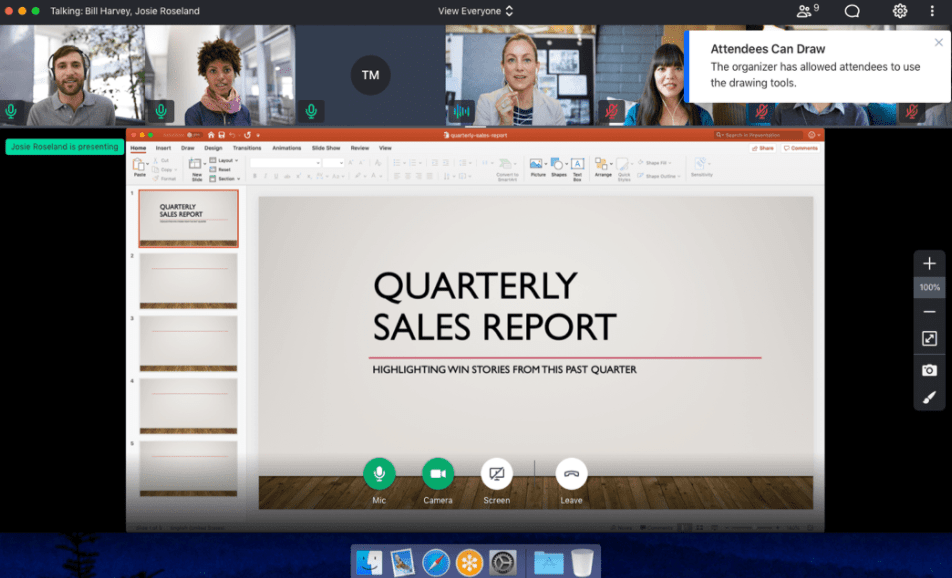
Pros: LogMeIn’s video conferencing software has some impressive features, including a “Smart Meeting Assistant” transcription service that automatically transcribes the meeting so you can search through and share detailed notes with others.
You can record the meeting and store the recording locally or in the cloud, and participants can join the meeting on desktop or through a mobile app.
Overall, GotoMeeting’s HD video and audio software is high-quality and integrates easily with Google Calendar or Chrome for increased efficiency.
Cons: GoToMeeting requires an error-fee data connection to work well, and some reviewers have noted the mobile app isn’t as user-friendly as they’d like. Additionally, the Professional plan doesn’t offer the transcription, note taking, or drawing features.
Price: $16/user per month, for up to 250 participants, for Business plan.
6. Skype

Pros: If you have a tight budget and you’re often calling people from across the globe, Skype could be a great option for you. The software is free to use, and doesn’t charge users for calling anyone from anywhere in the world. Video calls can also include up to 50 participants at once. The tool is easy to install and use.
Cons: The audio quality isn’t always great with Skype, particularly since Skype’s audio quality is based on bandwidth, so if users have a slow speed ISP, then audio quality will be negatively affected. Additionally, since Skype calls occur over the internet, there’s always a possibility that data will be intercepted. This makes it a less secure option than some others in the list.
Price: Free
7. Microsoft Teams

Pros: If you’re planning on hosting large webinars or conferences with over 250+ attendees, Microsoft Teams is a good tool for you to consider. The software allows up to 10,000 participants to meet at once, and lets you host with anyone inside or outside your organization.
Additionally, Microsoft Teams enables you to organize different departments or groups into “Teams” (which can be up to a few thousand people) — within those Teams, you can have separate channels of conversations and focus on different projects.
Microsoft Teams provides a few impressive features for increased engagement, including notifications, mentions, comments, GIFs and emojis in chats, and the ability to chat one-on-one or in groups. The software also offers advanced security features.
Cons: Microsoft Teams is an inclusive option for ensuring everyone within a given “Team” automatically has access to all the files, notes, and channels in the Team. Unfortunately, that means you don’t have permission settings to inhibit certain users from accessing files within a group, and you also can’t invite guest users to selected channels.
Price: Microsoft 365 Business Basic is $5/user per month (annual commitment) and allows for 300 participants, but doesn’t include the advanced security and compliance features, administration, or support. Microsoft 365 Business Standard is $12.50/user per month (annual commitment), and Office 365 E3 is $20/user per month (annual commitment) and includes everything Microsoft Teams has to offer.
8. RingCentral Video

Pros: RingCentral offers HD video and high-quality audio, and it’s a cost-effective option for an unlimited number of users, video meetings with up to 100 participants, and up to 24-hour meeting duration. The software enables you to hop easily between mobile and desktop devices, and provides seven layers of security.
Additionally, RingCentral provides personalized onboarding training and 24/7 live support, so if you feel your team might need support getting set up or in the future, this is a good option to consider.
Cons: RingCentral offers a recording feature but it’s only available as an offline option, meaning you need to download the recording as a local hard disk rather than a publicly available folder like Dropbox. The software also doesn’t come with its own calendar and task management function to integrate video meetings with your calendar events — for that, you’ll need to download the company’s Glip app.
Price: $24.99/user per month for the standard version.
9. Zoho Meeting
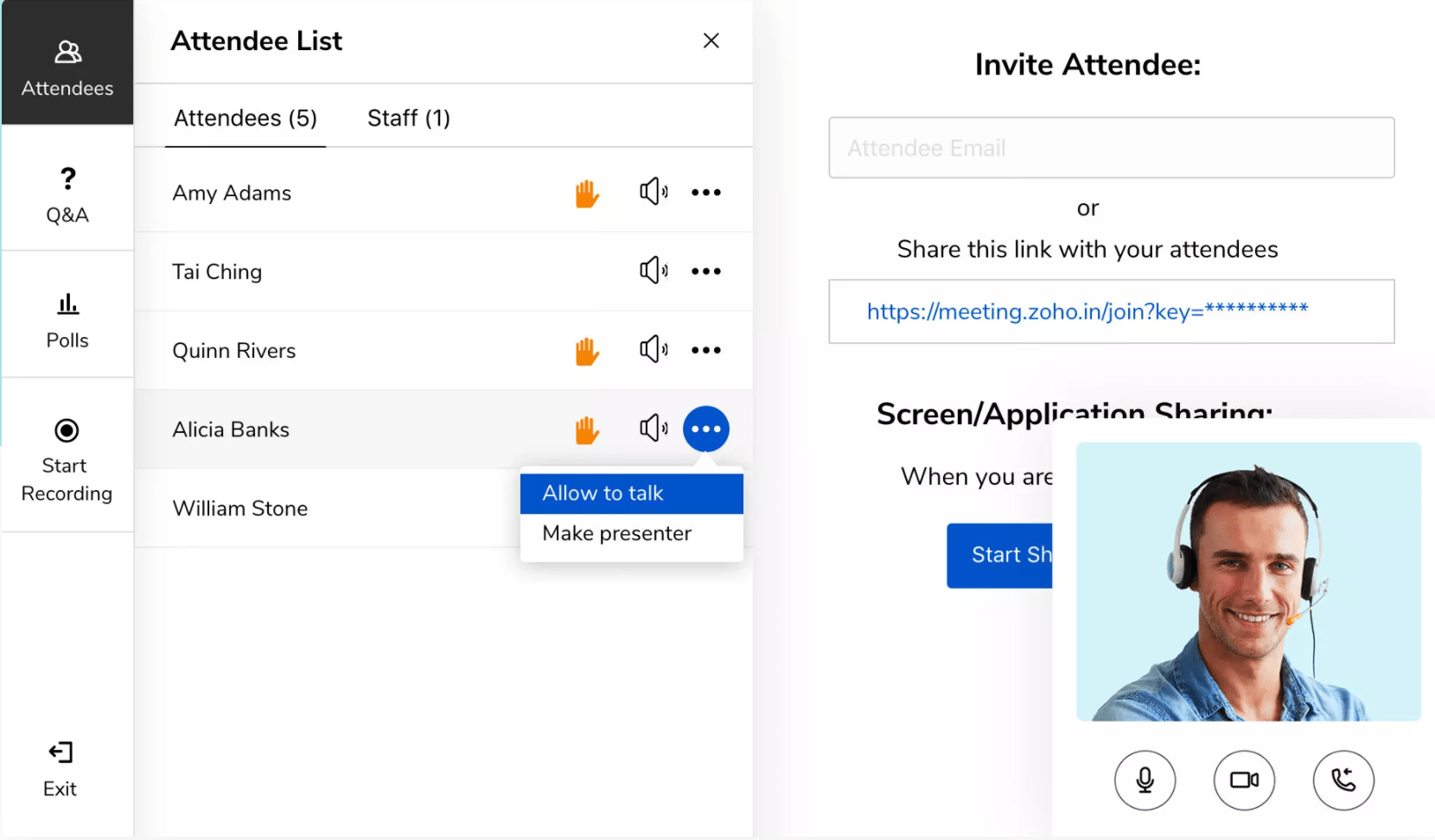
Pros: One of the most cost-effective options in the list, this is a good, user-friendly video conferencing software for small businesses. Users don’t need to download and install any software, since Zoho is hosted on a web browser, and the software offers all the basic features you’d need in a video conferencing tool, including screen sharing and meeting recordings.
Aditionally, you can use 100+ local dial-in numbers and 55+ toll-free numbers to join from different countries. Best of all, the interface is easy to navigate and use.
Cons: Zoho Meeting limits attendees to 100. If you need more participants than that, you’ll need to switch to Zoho Webinar. You also need to purchase an add-on if you plan on storing over 10 recordings.
The tool doesn’t offer some of the fancy features we’ve seen elsewhere in this list, including a smart assistant or cloud video recording. Still, this is a good option for smaller teams who don’t need all the bells and whistles.
Price: $2.50/host per month for 10 participants, $5/host per month for 25 participants, and $10/host per month for 100 participants.
10. Intermedia AnyMeeting
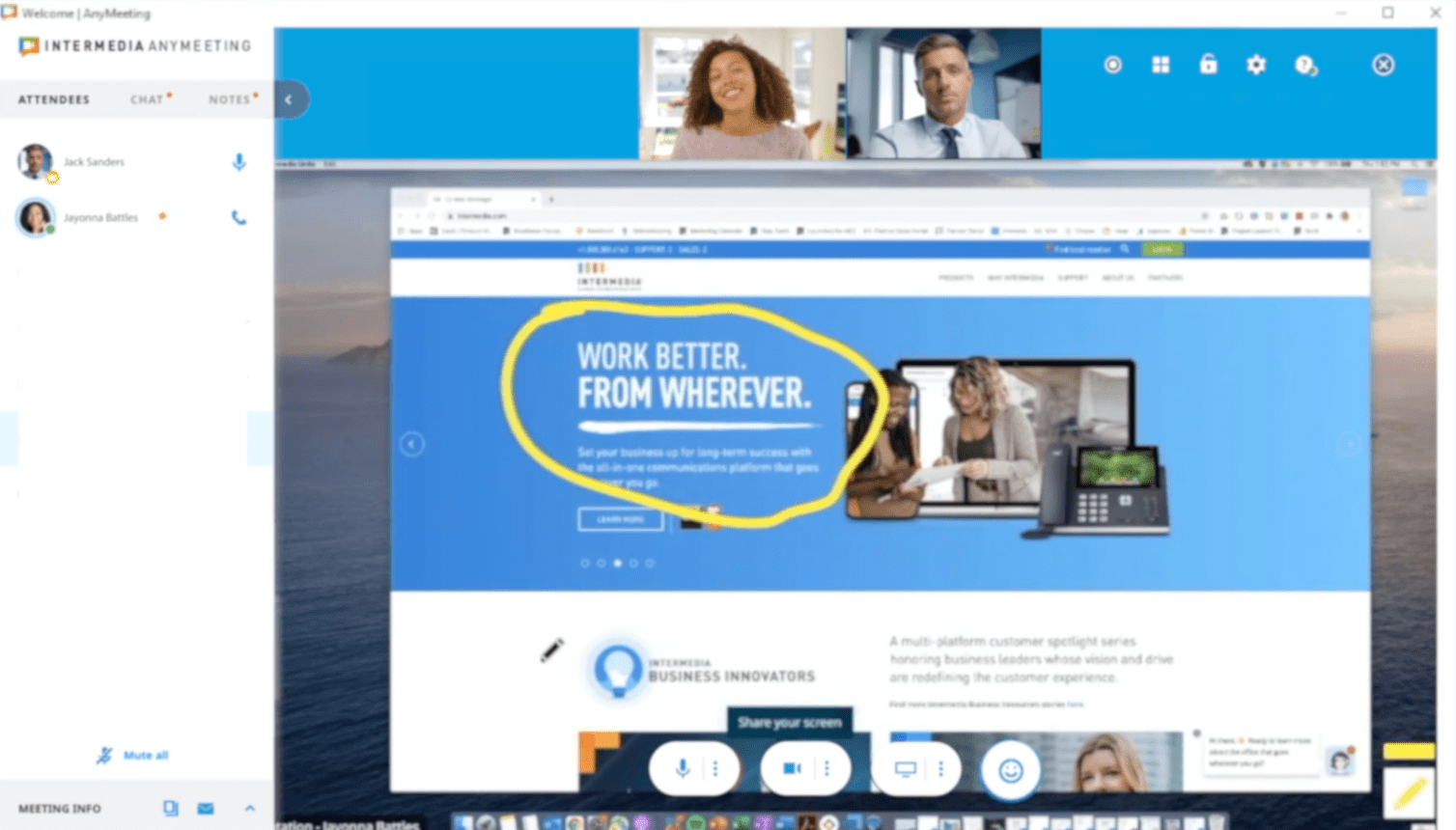
Pros: Intermedia AnyMeeting has a clean, easy-to-use interface and offers an impressive array of features — including an AI-powered smart assistant for meeting transcriptions, and screen annotations so participants can direct attention to key points on a shared screen — for a relatively low cost.
The software integrates with plenty of popular office tools including Outlook, G-Suite, and Slack, and offers unlimited recording storage and sharing capabilities. With the Pro version, you’re also able to create custom branded meetings with a company logo and personalized background.
Cons: Intermedia AnyMeeting doesn’t have end-to-end encryption of ongoing calls, which could raise privacy and security concerns. Additionally, some G2 reviewers have mentioned the audio quality could be better.
Price: $9.99/user per month for the Lite version, which enables up to 10 participants. $12.99/user per month for the Pro version, which enables up to 100 participants.
Remember — when choosing video conferencing software, it’s critical you keep your own team’s needs, resources, and requirements in-mind. If you’re still unsure after reading through this list, consider testing out a few demos or trial versions to see which feels best-suited for your brand.

![]()


